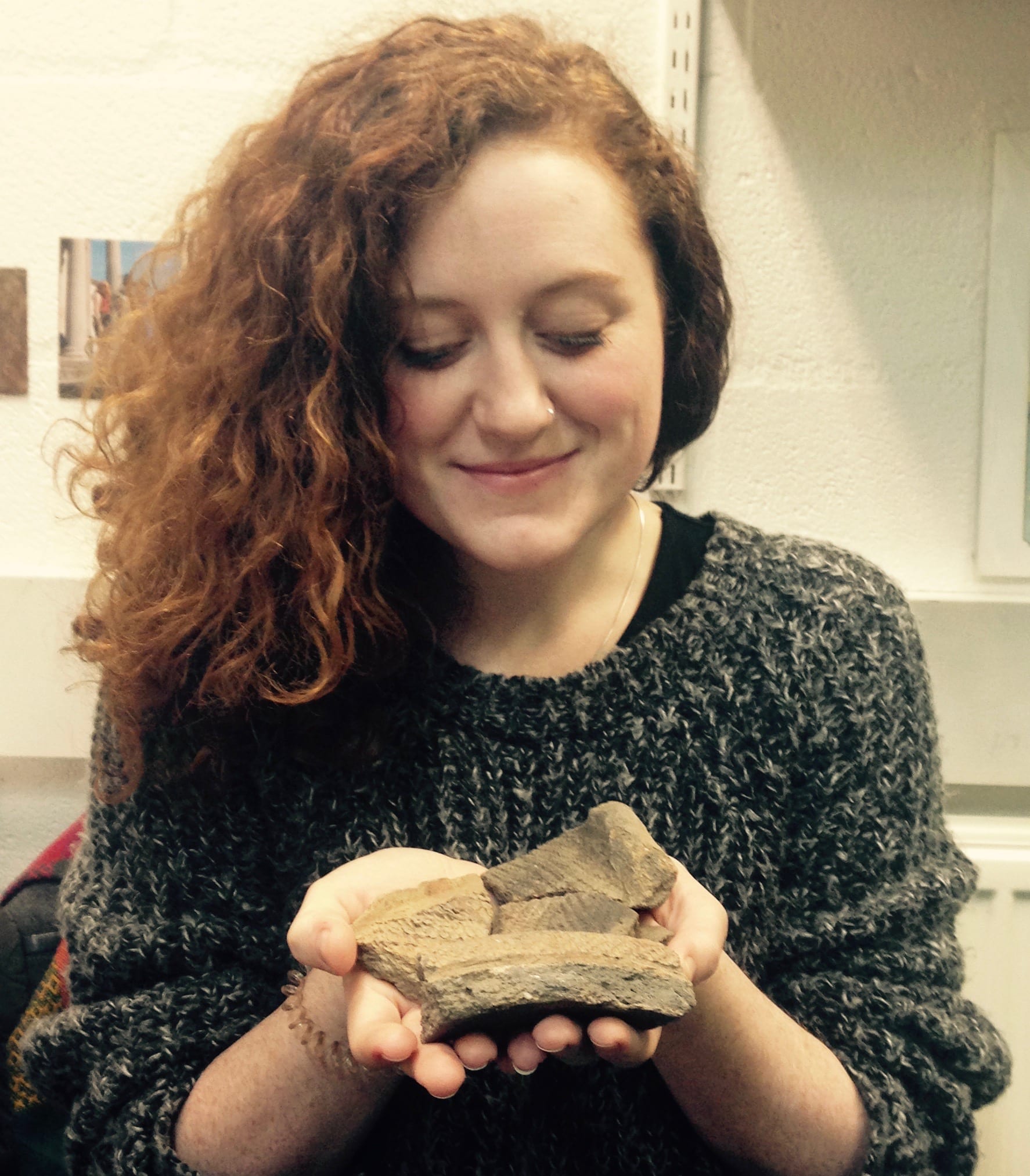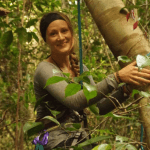Introducing the new Student Engagers!
By Arendse I Lund, on 1 May 2018
We have a new cohort of Student Engagers joining the team! We are incredibly pleased to welcome eight new PhD students working on everything from George Orwell to gibbon decline. Starting this month, you can look for them in the UCL Art Museum, Grant Museum of Zoology, and Petrie Museum of Egyptian Archaeology. You can also read a little about them and their research in their own words below.
Alexandra Bridarolli:
 I am a 2nd year PhD student at Eastman Dental Institute at UCL in London. I am also part of SEAHA, the centre for doctoral training in Science and Engineering in Arts, Heritage and Archaeology, a research centre also based at UCL bringing together other PhD students promoting heritage science in research. My background is in chemistry and I have a strong interest in material science. I have always been fascinated by the detective work carried out by scientists working on art objects, studying the materials they are made of, their stability, their properties.
I am a 2nd year PhD student at Eastman Dental Institute at UCL in London. I am also part of SEAHA, the centre for doctoral training in Science and Engineering in Arts, Heritage and Archaeology, a research centre also based at UCL bringing together other PhD students promoting heritage science in research. My background is in chemistry and I have a strong interest in material science. I have always been fascinated by the detective work carried out by scientists working on art objects, studying the materials they are made of, their stability, their properties.
My current research explores the use of innovative nanoparticles of cellulose for the consolidation of the canvas of modern paintings. These treatments could offer an alternative to current practices and materials in use in conservation which are known to put paintings at risks. This research greatly benefits from a close collaboration with painting conservators across Europe.
Mark Kearney:
 I am a 2nd year PhD student based at the SEAHA CDT in the Institute of Sustainable Heritage. My research is concerned with the decay of plastic objects of art and design. Contrary to popular belief, many plastics do not last forever, with some suffering rapid and often catastrophic decay patterns within the first 20 – 50 years of acquisition. As plastics have been one of the most important materials of the modern era, they now form central parts of museum’s collections.
I am a 2nd year PhD student based at the SEAHA CDT in the Institute of Sustainable Heritage. My research is concerned with the decay of plastic objects of art and design. Contrary to popular belief, many plastics do not last forever, with some suffering rapid and often catastrophic decay patterns within the first 20 – 50 years of acquisition. As plastics have been one of the most important materials of the modern era, they now form central parts of museum’s collections.
My project will exploit the information gained from the volatile organic compounds (VOCs) that are naturally emitted from plastics objects with the aim to detect and monitor their decay museum environments. I will work with Tate museums to study their sculpture collection, looking at cellulose acetate works of art, a polymer known to be problematic within museums.
Anna Pokorska:
 I am a second year PhD student at the Institute for Sustainable Heritage and SEAHA-CDT (Science and Engineering in Arts, Heritage and Archaeology Centre for Doctoral Training). My research project is focused on the stability of modern synthetic and semi-synthetic materials to visible light and is carried out at in association with the V&A museum and Philips.
I am a second year PhD student at the Institute for Sustainable Heritage and SEAHA-CDT (Science and Engineering in Arts, Heritage and Archaeology Centre for Doctoral Training). My research project is focused on the stability of modern synthetic and semi-synthetic materials to visible light and is carried out at in association with the V&A museum and Philips.
“Modern” materials such as plastics are a very important part of modern and contemporary art and design as well as social history collections from the 20th century. From high-profile artworks destined for a life in a gallery to everyday objects meant to be disposed of, more and more of plastic objects can be found in heritage institutions. However, our knowledge of their light sensitivity from a heritage perspective as well as the guidelines for their display and preservation are still limited. The project will, therefore, investigate the light stability of plastics to understand whether and how their light degradation is spectrally dependent. This will be done using visible radiation only as it would normally be in a museum or gallery environment.
Hannah Page:
 I am a fourth year part-time PhD student in the Archaeology department. My thesis focuses on sociocultural and political organisation and change in the early 2nd millennium AD in Uganda. My research aims to reconstruct key aspects of life at the site of Ntuusi through the detailed archaeometric (scientific) analysis of pottery. This type of ceramic analysis can be used to understand scale and organisation of production practices, identify cultural groups and understand networks of local and long-distance trade and exchange. I am also active in running excavations and coordinating field schools and outreach events in the UK and sub-saharan Africa.
I am a fourth year part-time PhD student in the Archaeology department. My thesis focuses on sociocultural and political organisation and change in the early 2nd millennium AD in Uganda. My research aims to reconstruct key aspects of life at the site of Ntuusi through the detailed archaeometric (scientific) analysis of pottery. This type of ceramic analysis can be used to understand scale and organisation of production practices, identify cultural groups and understand networks of local and long-distance trade and exchange. I am also active in running excavations and coordinating field schools and outreach events in the UK and sub-saharan Africa.
Sarah Gibbs:
 I completed an MA in English at Queen’s University and a Master of Library and Information Studies (MLIS) degree at McGill University in Canada. My doctoral dissertation at UCL focuses on George Orwell’s epistemology. My research combines concepts and methodologies from literary scholarship, philosophy, and library and information studies to discern how the ‘Tory-Anarchist-Turned-Socialist’ author of Nineteen Eighty-Four conceived of the relationship between knowledge and power, and what tools his epistemology offers to address current political realities.
I completed an MA in English at Queen’s University and a Master of Library and Information Studies (MLIS) degree at McGill University in Canada. My doctoral dissertation at UCL focuses on George Orwell’s epistemology. My research combines concepts and methodologies from literary scholarship, philosophy, and library and information studies to discern how the ‘Tory-Anarchist-Turned-Socialist’ author of Nineteen Eighty-Four conceived of the relationship between knowledge and power, and what tools his epistemology offers to address current political realities.
Cerys Jones:
 Multispectral imaging involves capturing images of an object illuminated in ultraviolet, visible and infrared light, in order to reveal features, such as faded text and underdrawings, that cannot be seen by the naked eye. My PhD research will optimise the workflow of multispectral imaging of heritage artefacts to enable heritage practitioners to capture and process images of their own collections without the need for a specialist imaging scientist.
Multispectral imaging involves capturing images of an object illuminated in ultraviolet, visible and infrared light, in order to reveal features, such as faded text and underdrawings, that cannot be seen by the naked eye. My PhD research will optimise the workflow of multispectral imaging of heritage artefacts to enable heritage practitioners to capture and process images of their own collections without the need for a specialist imaging scientist.
Caz Thompson:
 I am a PhD student studying the patterns and drivers of gibbon decline in China and Myanmar. Gibbons are the smallest of the apes known for their ability to sing and move gracefully through the trees. Nineteen of the twenty known species are on the brink of extinction, yet in the shadow of their great ape cousins, gibbons receive less funding and research attention. By adopting an interdisciplinary approach, involving both biological and social sciences, I aim to understand the relationship between co-existing humans and gibbons. I currently focus on two species threatened by habitat loss and hunting: the Hainan gibbon, which is the rarest primate in the world with only 26 individuals, and the newly discovered Skywalker Hoolock gibbon with only 200 individuals remaining.
I am a PhD student studying the patterns and drivers of gibbon decline in China and Myanmar. Gibbons are the smallest of the apes known for their ability to sing and move gracefully through the trees. Nineteen of the twenty known species are on the brink of extinction, yet in the shadow of their great ape cousins, gibbons receive less funding and research attention. By adopting an interdisciplinary approach, involving both biological and social sciences, I aim to understand the relationship between co-existing humans and gibbons. I currently focus on two species threatened by habitat loss and hunting: the Hainan gibbon, which is the rarest primate in the world with only 26 individuals, and the newly discovered Skywalker Hoolock gibbon with only 200 individuals remaining.
Jen Datiles:
 I am a PhD student at the UCL School of Pharmacy studying food and medicinal plants that were exchanged between Asia and the Americas via the Spanish Galleon Trade (1565-1815). Using selected plant species as case studies, my research aims to link historical documentation with modern use-knowledge of traditional food-medicines through fieldwork and work in various archives and herbaria.
I am a PhD student at the UCL School of Pharmacy studying food and medicinal plants that were exchanged between Asia and the Americas via the Spanish Galleon Trade (1565-1815). Using selected plant species as case studies, my research aims to link historical documentation with modern use-knowledge of traditional food-medicines through fieldwork and work in various archives and herbaria.
Welcome to the team!
 Close
Close

